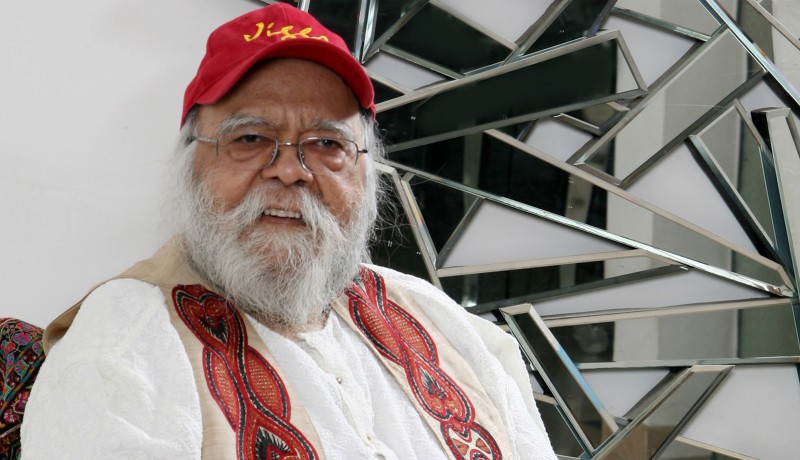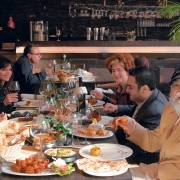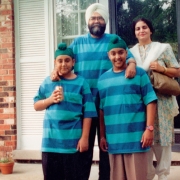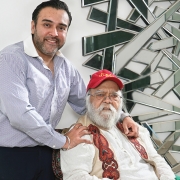
People

Food and family combine deliciously for pioneering food writer and consultant Jiggs Kalra as he works with son Zorawar to delight a new generation of Indian diners, discovers Arati Rajan Menon
In 1971, when food writing was neither a fad nor fashionable—how times change!—The Times of India commissioned J Indersingh Kalra to write ‘Platter Chatter’, India’s first restaurant review column. For the 23 year-old culinary enthusiast, it was the beginning of a journey spanning over four decades as columnist author, gastronome, food consultant to hospitality’s finest, and restaurateur. For ‘Jiggs’, as the world knows him, there have been landmarks aplenty: ‘Rasoi’, the first syndicated column of its kind; Daawat, India’s first reality food show; Prashad–Cooking with Indian Masters, dubbed ‘the Bible of Indian cuisine’ with 7 million copies sold and counting; and the honour of being the first Asian to be inducted into the prestigious International Food & Beverage Hall of Fame. Even more significant, he has helped revive India’s lost cuisine and introduced it to the world—as well as discerning Indian gourmands.
Today, while he continues to consult with other restaurants, his focus is on being ‘mentor’ to Massive Restaurants, a venture by his son Zorawar that brings innovative and inventive food concepts to a new generation of Indians. It encompasses Masala Library, a premium gourmet fine-dining concept (Mumbai); Made in Punjab, a smart-casual funky Punjabi restaurant (Delhi and Mumbai); and Farzi Cafe, a molecular bistro that serves up Indian food with a twist (Gurgaon). A fourth concept, Papaya, will open soon in Mumbai—this pan-Asian concept will be a departure for the Kalras, whose heart lies with Indian cuisine.
“Both Dad and I are crusaders for Indian food,” affirms Zorawar. “Indian cuisine is the most complex, sophisticated and elaborate and we want it to be recognised as the top cuisine in the world.” For the father who has dedicated his life to the same end, this is sweet music indeed. Jaunty in his trademark baseball cap and colourful red vest—“It’s a favourite; I’ve had it for years”—he visibly lights up when Zorawar enters the room. “Can you believe how lucky I am to have a son like this?” he beams.
Legacy means everything to Kalra. Much of our conversation at his spacious home in Gurgaon, which he shares with wife Lovejeet and Zorawar’s family, is peppered with references to his grandchildren. They’re away in Chandigarh and the house is silent—too silent, insists the doting grandfather. “You should meet my granddaughter, the most adorable creature on the planet,” he says. “She’s my little poppet and I plan to teach her everything I know.” She’s a lucky girl.
Excerpts from an interview
You are a self-taught cook. Who inspired you?
I come from a typical Punjabi family; my father was from the Indian Armed Forces and a stickler for discipline. He expected me to follow in his footsteps but I had other plans. Reading and writing were a passion from a very young age. My exposure to the kitchen happened thanks to my grandmother—her mutton beliram still remains my favourite—and my mother, one of the finest cooks I’ve ever known. I consider them my mentors.
Another guru—and friend—was the late Khushwant Singh, we hear….
Yes. After college, I got the opportunity to work with The Times of India in Mumbai. As I was new to the city and a foodie by nature, I found it tough to find recommendations on good places to eat. In those days, there were no food columns in print media or shows on Doordarshan, then the only television channel. This gave me the idea to start a food column. Mr Khushwant Singh, my editor, supported the idea; that’s how I began writing on food.
How did your TV show Daawat—a first for India—come about?
We were invited by Sashi Kapur, then director-general of Doordarshan Delhi, and Jaya Chandiram of the Central Production Centre to produce a pioneering food show on television to explore regional cuisines and make the audience aware of India’s culinary vastness and history. This required extensive research, travel and interaction with various communities, including in remote areas. I suggested we also incorporate information about the Ayurvedic basis of Indian cuisine, so we met nutritionists, hakim, vaidya and scholars of history. It took over a year to get our research in place before commencing the shoot. Our work entailed the herculean task of passing the test of two disciplines: videotainment and gastronomy. Daawat became an instant hit and a benchmark for Indian television as the country’s first reality food show. It was also in great demand overseas and remains one of the sizeable commercial successes of the country’s public broadcasting network. This was followed by Zaike ka Safar on Zee TV.
Writing a book must have been a seamless transition for you.
I had already started working on my first book, Prashad–Cooking with Indian Masters. It is one of the most sought-after books on Indian cuisine and included as part of the curriculum in hotel management institutions. After the success of Daawat, Zaike ka Safar, Prashad and some of my other works, I co-wrote a few other titles on Indian cuisine with my friend Pushpesh Pant, who was my companion on the trails of Daawat.
Now, food shows are ubiquitous.
Today, everyone has become interested in cooking and wanted to be a chef! It is no longer a profession that is looked down upon. Much of this can be attributed to numerous culinary shows, Indian and international, which have opened avenues that a lot of people weren’t aware existed or thought possible.
Your columns, books, TV shows have served as a record of India’s food history. What impelled you to document our culinary heritage and how did you go about it?
When I started writing my food column, I realised that there were no written records capturing the centuries-old tradition of Indian food. Everything was based on andaaza [guesswork] and handed over by mother to daughter before marriage or by mother-in-law to her daughter-in-law after marriage. In this process, the knowledge of many culinary marvels and iconic preparations started diminishing and, in some cases, was lost altogether. As my column began to garner interest from audiences of all ages and demographics, my writing started taking the shape of something larger. I began to interact with chefs, erstwhile royal khaansaama, housewives, historians and culinary legends from various regions to uncover India’s culinary history and record data. I started taking notes, comparing them and compiling them. Wherever there were differences, I took a median of all and wrote the recipes. Indian food had never been documented; there was no ready text and everyone was following their own version of the dish, leading to the dilution of recipes. I took it upon myself to revive, restore and record Indian cuisine through my various interactions.
Could you give us an example?
There was this one time when I was asked to gather recipes from ladies who had crossed the border during Partition. After painstaking research, I was able to find and connect with 10 such ladies; most of them were from Sindh province. During the course of my interaction and cooking sessions with them, I realised they all had the same recipe for a specific dish, with slight differences here and there. I enquired upon the origin of the recipe and they all had almost the same thing to say—it had been handed down and followed in their household for generations. All 10 recipes were based on the andaaza system of cooking; I wanted to change this through recording all of them.
Please share some highlights of your long and rich professional career.
One of the biggest highlights was when I had the privilege to serve His Excellency Prince Charles and the late Princess Diana during their trip to Jaipur. Another was being inducted into the International Gourmet Hall of Fame. However, the happiest moment of my life was when my elder son Zorawar came home after completing his MBA from Boston’s Bentley University and shared that he wants to get into the hospitality industry. I was ecstatic when he said he wanted to realise his dream of becoming a restaurateur and one day create my magnum opus. This came true the day we launched Masala Library by Jiggs Kalra in Mumbai.
One can see that family means everything to you!
They are the true highlights of my life! My wife Lovejeet has stood by me through the toughest of times and helped raise the best children we could ask for, our sons Zorawar and Ajit. The family has grown to encompass my daughters-in-law Dildeep and Sukhu, and my most adorable grandchildren Amaara, Fateh and Aaliyah.
How has your relationship with your Zorawar evolved with the establishment of Massive Restaurants?
The journey working alongside him hasn’t been an easy one but both of us have found common ground, agreeing to disagree, thereby creating innovative concepts. He understands his audience extremely well and it’s an added advantage that he has a highly developed palate of his own to be able to work the flavours of dishes well, making my life a little easier. So while I help him on the cuisine knowledge side of things, his hard work, persistence and passion for Indian food drive the business side.
How has the dining-out concept in India evolved? Has Indian cuisine lost ground to foreign cuisines?
The actual proliferation in dining out in India has come about only in the past two decades and these are exciting times for restaurateurs and chefs as well as diners. Competition is always healthy and it has made us stand up and take note of the need to focus more on Indian cuisine and work on offering uniqueness to bring it back to the forefront, in India and globally. Our restaurant concepts Masala Library by Jiggs Kalra, Farzi Café and Made in Punjab have been credited with doing this over the past two years. Today, we see a lot more diners choosing to dine at an Indian restaurant compared to four or five years ago.
Tell us the thought process behind the food concepts you offer.
Indian cuisine must take centre-stage once again and be at the forefront of innovation while catering to the evolving palate. Since its commercial proliferation, it had come to a point of stagnation and, thus, we believe we should make the effort to elevate Indian food and reintroduce it to the world in its modern avatar—we call it Indian Cuisine, Version 2.0. Progressive Indian cuisine, retaining the traditional essence of Indian food, is the way forward. We aim to give the cuisine a new lease of life, appealing to guests of all ages, generations and demographics, and establishing it as the primary choice of cuisine while making plans to dine out.
Are Indians today game for experimental food and new concepts?
With exposure to global trends, guests are now looking for unique, experiential dining options that don’t just offer good food but an avant-garde dining experience surprising their palate and senses. The tremendous response we have received across all our restaurant concepts are proof of that. In fact, the basis of our restaurant Farzi Café was to bring Indian food back ‘in vogue’, breaking the mould of the cuisine being old, boring, very heavy to digest and lacking novelty. It’s is my favourite of all our restaurants!
Today, what is the perception of Indian cuisine abroad?
Mostly the concept of Indian cuisine outside India is focused on the dishes found and served on the dining tables in North India and need not necessarily represent the country’s culinary landscape. Despite a global presence, the cuisine has lacked authenticity, standardisation and a sense of panache. As a unified region, we have never focused on taking pride in our cuisine and presenting it in the right manner to the rest of the world, leading to abundant variations, most of it not remotely authentic. Sadly, the cuisine hasn’t seen much innovation over time; if you ask anyone to give you a visual description of Indian cuisine, more often than not you will get to hear about the classic black dal in a deep bowl with a swirl of cream; rich, main course dishes simmered in strong spices; traditional breads stacked in a small basket glazed with butter; and overtly sweet desserts presented in locally sourced tableware. The portions are huge, with a focus on quantity rather than quality and presentation. Many international travellers during their visit to India have been rather surprised with the vastness and robust nature of Indian food and exclaimed on the absolute lack of similar flavours among a multitude of restaurants overseas serving Indian food. However, in the recent past, with us taking pride in presenting our own food in the right light, the perception of Indian food is fast changing and I am hopeful that in coming years, Indian food will lead with its authenticity, innovation and robustness.
Other than your role as mentor to Massive Restaurants what keeps you busy today?
My grandchildren. I also watch TV—lots of news, the series Ashoka. I have missed out on a lot of medieval Indian history. They should make a show on Razia Sultana instead of the rubbish they usually serve up. I also enjoy watching movies. Last night, I saw Ram Leela with Deepika Padukone—it blew my mind [smiles cheekily].
Do you find that age has diminished your passion for food?
What is age but a number! We are as young or old as the heart and mind allow us to be. If you want to follow your passion, nothing can come in the way, not even age.
We read somewhere that you have turned vegetarian over time. Is that true?
I’m a hardcore Punjabi and eat non-vegetarian food with a lot of pleasure even today. Of course, when you end up eating more home-cooked meals, the diet is controlled with a balance between vegetarian and non-vegetarian food, which at my age you do need to be a little cautious about [laughs]. Actually, truth be told, I tend to become vegetarian when I feel like it. My love for veggies happened because of my father who was an ardent fan of vegetables. He would insist on making even non-vegetarian dishes with at least one vegetable as part of them. Lauki mussalam is one my favourite dishes.
Finally, tell us your food philosophy in a nutshell.
There is nothing called andaaza. If you want the dish to taste consistent, follow a tried-and-tested recipe. And if it’s your own creation, don’t be dependent on your memory; record it in your own cookbook. This would make the perfect gift for your children.
Quick bites with Jiggs!
Favourite dish: Kaleji ka raita; easy to make and wonderful to taste
On your table every day: Raita
Strangest dish you ever tasted: Unusual but wonderful gosht ki kadhi
Go-to comfort food: Murgh malai tikka; not too hot and easy to digest
Dishes you detest: I don’t detest any dish but I’m not too fond of karela [bitter gourd] and methi [fenugreek]. However, I have to live with them because of my diabetes
From Kalra’s kitchen
Punjabi Khichdi
Khichdi is a classic dish. Don’t forget to have it with khichdi ke chaar yaar… dahi, papad, ghee, achaar. Though, if you want to keep it light, eat it sans accompaniment. I indulge each time I return from a foreign trip.
Ingredients
- Dhuli (yellow) moong dal: half cup
- Basmati rice: half cup
- Water: 4-and-a-half cups
- Clarified butter (ghee): 1 tsp
- Cumin seeds (jeera): 1 tsp
- Black peppercorn: 6
- Cloves (lavang): 4-5
- Onion: 1, finely chopped
- Ginger: ½”, grated
- Garlic cloves and curry leaves: 6-7
- Salt: to taste
Method
Wash rice and dal in running water. Drain. Heat the ghee in a pan. Add cloves and black pepper, followed by cumin. When it crackles, add onion, ginger, garlic and curry leaves (they’re good for the heart and add to the flavour). Stir it until golden brown. Then, add rice and dal, followed by water—thrice the quantity of rice and dal. Let it boil, cover and simmer, stirring occasionally until the mixture is thick and viscous and of porridge like consistency. Serves two.
(Featured in Harmony–Celebrate Age, August 2004)
Photo: Himanshu Kumar, Outlook Magazine Archival Photo courtesy: Jiggs Kalra Featured in Harmony — Celebrate Age Magazine July 2015
you may also like to read
-
For the love of Sanskrit
During her 60s, if you had told Sushila A that she would be securing a doctorate in Sanskrit in the….
-
Style sensation
Meet Instagram star Moon Lin Cocking a snook at ageism, this nonagenarian Taiwanese woman is slaying street fashion like….
-
Beauty and her beast
Meet Instagram star Linda Rodin Most beauty and style influencers on Instagram hope to launch their beauty line someday…..
-
Cooking up a storm!
Meet Instagram star Shanthi Ramachandran In today’s web-fuelled world, you can now get recipes for your favourite dishes at….










